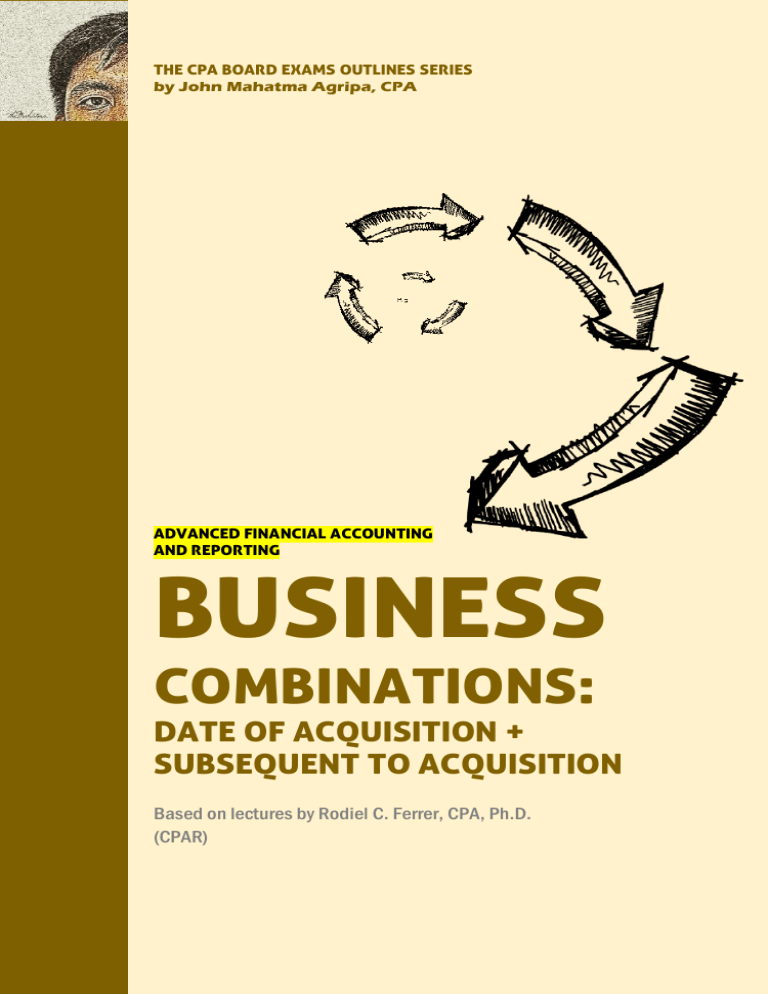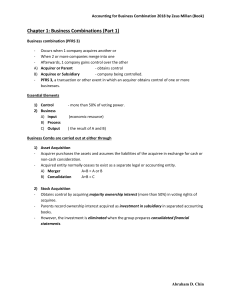Business Combinations: Advanced Financial Accounting Textbook
advertisement

THE CPA BOARD EXAMS OUTLINES SERIES by John Mahatma Agripa, CPA ADVANCED FINANCIAL ACCOUNTING AND REPORTING BUSINESS COMBINATIONS: DATE OF ACQUISITION + SUBSEQUENT TO ACQUISITION Based on lectures by Rodiel C. Ferrer, CPA, Ph.D. (CPAR) GENERAL CONCEPTS: BUSINESS COMBINATION AT DATE OF ACQUISITION Business combinations are transactions where the acquirer obtains control over another entity called the acquiree, through either asset acquisition or purchase of at least 51% of the acquiree’s voting stocks In an asset acquisition, the entire net assets of the acquiree are obtained, resulting to either the dissolution of the acquiree (statutory merger) or the formation of a new entity with the dissolution of both the acquirer and acquiree (statutory consolidation). Since one or both entities are dissolved, there is no parent-subsidiary relationship in asset acquisitions In stock acquisition, on the other hand, both entities continue to operate after the transaction. If the acquirer obtains less than the entire voting stocks of the acquiree, there emerges a parentsubsidiary relationship, in which case the non-controlling interest (NCI) is recognized Accounting business combinations uses the purchase/acquisition method, where acquiree assets are measured at fair value. The outlawed pooling-of-interest method records acquiree assets at book value All business combinations require disclosure of who is the acquirer, when is the acquisition date (when the fair value of acquiree assets shall be based, which is still adjustable one year after this date), the identifiable assets (excluding acquiree goodwill), the non-controlling interest, and the goodwill or gain from acquisition TOTAL ASSETS, LIABILITIES AND EQUITY ON DATE OF ACQUISITION As an alternative to the ‘CARLAS’ formula, the total assets, 2 liabilities and equity of the acquirer right after the acquisition can be computed as follows. The items shall be discussed on subsequent sections Total acquirer assets, at book value ADD: Total acquiree assets, at fair value ADD: Goodwill DEDUCT: Cash, non-cash assets paid DEDUCT: Expenses paid Total assets xx xx xx xx xx xx Total acquirer liabilities, at book value ADD: Total acquiree liabilities, at fair value ADD: Bonds, notes and other debt issued ADD: Contingent consideration ADD: Expenses not yet paid Total liabilities xx xx xx xx xx xx Total acquirer equity ADD: Non-controlling interest ADD: Shares issued as part of payment, at fair value ADD/DEDUCT: Gains/losses from bargain purchase, previously-held investments, contingent consideration DEDUCT: All expenses, regardless of payment Total equity xx xx xx xx xx xx GOODWILL / GAIN ON BARGAIN PURCHASE OPTION Goodwill results if the acquirer pays more than the fair value of the net assets of the acquiree. Otherwise, a gain on bargain purchase option emerges. Goodwill is not an identifiable asset, and therefore not recorded by the acquirer if the acquiree has preexisting ones (and thus not included in the formula above) In cases that the business combination involves acquisition of two or more acquirees, goodwill from the acquirees is not combined. If there’s a gain on one acquiree, it is not netted against the goodwill of the other acquiree Goodwill/gain from the combination can be computed with either of the following formulas: 3 Fair value of previously-held interest ADD: Fair value of additional consideration ADD: Fair value of contingent consideration payable ADD: Present value of deferred consideration Purchase price ADD: Fair value of non-controlling interest Fair value of acquiree DEDUCT: Book value of acquiree’s net asset Excess ADD: Overvalued assets DEDUCT: Undervalued assets Goodwill / (Gain) xx xx xx xx xx xx xx xx xx xx xx xx Purchase price (includes control premium, if any) DEDUCT: Fair value of acquiree net assets Goodwill / (Gain) xx xx xx Control premium refers to additional payments made by the acquirer to make sure the acquiree sells its assets to them The fair value of acquiree net assets are provisional, which means they can still be changed within one year from the date of acquisition, subsequently affecting goodwill. The changes are applied retrospectively, which means if there is a change on fair values a few months from the date of acquisition, the resulting goodwill shall be the goodwill as of the date of acquisition Goodwill is allocated between the parent and subsidiary using their interest percentages, while any gain is all allocated to the parent NON-CONTROLLING INTEREST AND THE D&A SCHEDULE As mentioned, non-controlling interest (NCI) is only recognized in stock acquisitions of less than the entire voting shares of the acquiree. This is measured at fair value or implied value, if fair value is not available. This forms part of goodwill computation and of total equity 4 The implied value of NCI can be computed as follows: Purchase price DEDUCT: Control premium, only if included in purchase price DIVIDE: Controlling interest % MULTIPLY: Non-controlling interest % NCI implied value xx xx xx xx% xx xx% xx The amount of NCI to be recorded follows the floor test – it must be the higher between the given fair or implied value of NCI, and the proportionate/relevant share. In no instance should the NCI be lower than the proportionate/relevant share. The floor test may be overridden in some jurisdictions, but for examination purposes it shall always be followed NCI and goodwill can actually both be computed with the D&A schedule, as follows: Fair value of subsidiary Relevant share Goodwill / (gain) Total (f) (b) (g) Purchase price (a) (c) xx NCI (e) (d) xx First enter the purchase price (includes the control premium) in (a) and the fair value of the acquiree’s net assets in (b). Remember that existing goodwill of acquiree is not included. Multiply (b) with the controlling interest % for (c) and with the NCI % for (d) (d) is the proportionate/relevant share, which is the basis for the floor test. If the NCI’s fair value or implied value is lower than this amount, (d) is copied to (e). (a) and (e) are then added, and deducted with (b) for the goodwill/gain (g) PREVIOUSLY-HELD INTEREST This refer to the interest on the acquiree by the acquirer below 5 51% such as investments in associate and equity securities that didn’t grant it control over the former. Its fair value shall form part of the purchase price for the computation of goodwill, which can be computed as follows: Additional consideration for the additional interest to obtain control DIVIDE: Additional interest % MULTIPLY: % of previously-held interest Fair value of previously-held interest xx xx% xx xx% xx For instance, if the acquirer previously had an investment in associate (25%) over the acquiree, and pays Php 100,000 for another 30% interest, thereby granting it control, Php 100,000 is the additional consideration and the 30% is the additional interest percentage. 25% is the previously-held interest percentage Gains/losses from previously-held interest forms part of total equity. To compute, the carrying value of the investment in associate (or any other investment) has to be adjusted (for income, dividends, impairment) and compared with the computed fair value A business combination in which this arises is called step-up acquisition CONTINGENT LIABILITY PAYABLE Also called upfront fee, these are additional payments promised by the acquirer to be paid if certain conditions are met. These amounts are presented in their present values. The present value forms part of purchase price, and gains/losses form part of total equity Since provisional, this present value may change within one year of the acquisition, which retrospectively affects goodwill. 6 However, if the change is the result of meeting earnings targets, milestones in research and development, or reaching specific markets, goodwill is not adjusted. In such cases, a separate account is made The gains/losses are the changes in the consideration payable. Since a liability, increases in the amount is a loss, and vice versa EXPENSES AND OTHER ITEMS There are generally three expense accounts in business combinations – direct costs, indirect costs, and costs to issue and register (or stock issuance costs). They form part of the computation for total assets, liabilities and equity These expenses, including direct cost, are not capitalized in the investment in subsidiary account Also included in the purchase price in the computation of goodwill are fully amortized and internally-generated intangible assets, both of which are considered identifiable GENERAL CONCEPTS: BUSINESS COMBINATION SUBSEQUENT TO ACQUISITION Problems on business combination subsequent to acquisition revolve around the preparation of consolidated financial statements and computation of consolidated net income in the presence of a parent-subsidiary relationship In its separate financial statements, the parent/holding company accounts for its control over its subsidiary with an investment in subsidiary account, measured with the cost model. The account is composed of cash, share or contingent considerations given 7 COMPUTATION OF CONSOLIDATED NET INCOME (CNI) There are in total 27 items considered in the computation of consolidated net income, divided into the parent’s and that of the non-controlling interest. Components are discussed in the subsequent sections CNI - Parent CNI - NCI Parent net income xx DEDUCT: Dividend from subsidiary xx Income from own operation of parent xx ADD/DEDUCT: Share in net income/loss of subsidiary xx xx DEDUCT: Amortization of undervaluations xx xx ADD: Amortization of overvaluations xx xx ADD: Gains from bargain purchase, previously-held interest and contingent considerations xx DEDUCT: Impairment losses xx xx ADD: Realized profit from beginning inventory (RPBI), downstream sales xx DEDUCT: Unrealized profit from ending inventory (UPEI), downstream sales xx ADD: RPBI, upstream sales xx xx DEDUCT: UPEI, upstream sales xx xx ADD: Realized gains from upstream sales xx xx ADD: Realized gains from downstream sales xx DEDUCT: Realized losses from upstream xx xx DEDUCT: Realized losses from downstream xx DEDUCT: Unrealized gains from upstream xx xx DEDUCT: Unrealized gains from downstream xx ADD: Unrealized losses from upstream xx xx ADD: Unrealized losses from downstream xx xx Consolidated net income (parent + NCI) xx xx Items shared by both parent and the non-controlling interest – particularly share in net income/loss of subsidiary, amortization of undervaluations and overvaluations, and profits/gains/losses from upstream sales – are divided according to ownership percentage If the business combination occurred sometime during the year, say in May, the said items shall be prorated according to the remaining months of the year (multiplied by 8/12) 8 The exception would be impairment losses, which is divided according to the proportion of goodwill belonging to the parent and NCI as computed with the D&A schedule (see page 5). This is not prorated Gains from bargain purchase, previous interest and contingent consideration are only included in the computation if the net income related to the year of the business combination OVER/UNDERVALUATION OF ASSETS There is overvaluation if the book value of the asset exceeds its market value. On the opposite case, there’s undervaluation Amortization of the over/undervaluation depends on the related asset. If the asset is depreciable, the amount is amortized as it is depreciated, according to remaining useful life. If the asset is part of inventory or is non-depreciable like land, the amount is amortized if the asset is sold If silent, the amount of inventory given is assumed to be all sold during the year, thus all amortized INTERCOMPANY SALES: UPSTREAM AND DOWNSTREAM SALES Intercompany sales are transactions between the parent and subsidiary, classified as either upstream (sale of subsidiary to parent) or downstream (sale of parent to subsidiary). The sale may be that of inventory, depreciable assets or land As seen in the formula, all gains and losses, realized or unrealized, from upstream sales go both to the parent and subsidiary – divided according to the percentage of interest. 9 Gains and losses from downstream sales only go to the parent The gains and losses may be realized or unrealized. There is an unrealized gain if the seller (parent or subsidiary) transfers the asset to the buyer (subsidiary or parent) at a price higher than book value. The gain is only between the two entities, so its effect is removed from consolidated income – unrealized gains are deducted, while unrealized losses are added back. Realized gains occur when the transferred asset is sold to a third party at a price higher than the book value The treatment of these gains and losses differ according to the related asset – inventory, depreciable asset or land Unrealized profit from ending inventory (UPEI) is actually the markup on inventory transferred from the parent/subsidiary still remaining on the stocks. Ending inventory purchased from outside sources does not constitute UPEI. On the following year, this very amount becomes realized profit from beginning inventory (RPBI), assuming of course that the entire inventory is sold next year to third parties. If the same inventory is not sold, UPEI for that inventory will remain the following year Unrealized gains or losses from transfer of depreciable assets and land is recorded only in the year they are transferred to the parent/subsidiary. For depreciable assets, this amount is amortized on a straight-line basis according to the asset’s remaining useful life, and recorded as realized gains or losses. If the asset is sold to third parties, the unamortized amount is fully recorded as realized For land, the unrealized amount becomes realized only if the land is sold to third parties. This unrealized amount is strictly the only amount that shall be realized, even if the land was sold at a way higher price 10 CONSOLIDATED FINANCIAL STATEMENTS The preparation of consolidated financial statements is only required for public entities. The computation of total assets and liabilities follow the formulas on page 3. Formulas for other consolidated components of the financial statements are as follows: Parent sales ADD: Subsidiary sales DEDUCT: Intercompany sales, at selling price Consolidated sales xx xx xx xx Parent COGS ADD: Subsidiary COGS DEDUCT: Intercompany purchases, at selling price ADD: UPEI, upstream and downstream DEDUCT: RPBI, upstream and downstream Consolidated cost of goods sold xx xx xx xx xx xx Parent gross profit ADD: Subsidiary gross profit DEDUCT: UPEI, upstream and downstream ADD: RPBI, upstream and downstream ADD: Amortization of inventory overvaluation DEDUCT: Amortization of inventory undervaluation Consolidated gross profit xx xx xx xx xx xx xx Parent expenses ADD: Subsidiary expenses ADD: Amortization of depreciable asset undervaluation DEDUCT: Amortization of depreciable asset overvaluation ADD: Realized losses from depreciable assets DEDUCT: Realized gains from depreciable assets Consolidated expenses xx xx xx xx xx xx xx Parent shareholders equity ADD: Non-controlling interest, at date of acquisition ADD: Parent net income ADD: Subsidiary net income DEDUCT: Parent dividend declarations DEDUCT: Share of dividend from subsidiary Consolidated shareholders equity xx xx xx xx xx xx xx Parent retained earnings, beginning ADD: Parent net income DEDUCT: Parent dividend declarations Consolidated retained earnings xx xx xx xx 11




![[Date] [Name of College] ATTN: [Department]](http://s2.studylib.net/store/data/015675584_1-19c1f2d4f2acfcfa6a51fd36241fad38-300x300.png)